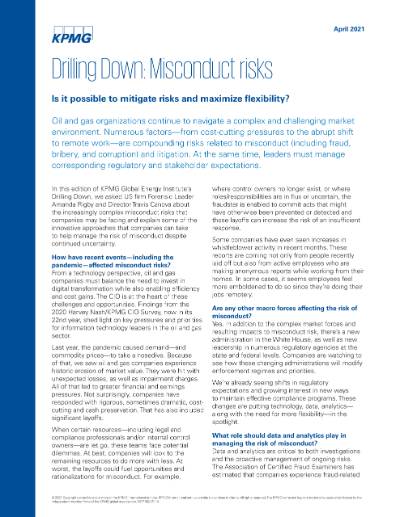Oil and gas organizations continue to navigate a complex and challenging market environment. Numerous factors—from cost-cutting pressures to the abrupt shift to remote work—are compounding risks related to misconduct (including fraud, bribery, and corruption) and litigation. At the same time, leaders must manage corresponding regulatory and stakeholder expectations.
In this edition of KPMG Global Energy Institute’s Drilling Down, we asked US firm Forensic Leader Amanda Rigby and Director Travis Canova about the increasingly complex misconduct risks that companies may be facing and explain some of the innovative approaches that companies can take to help manage the risk of misconduct despite continued uncertainty.
How have recent events—including the pandemic—affected misconduct risks?
From a technology perspective, oil and gas companies must balance the need to invest in digital transformation while also enabling efficiency and cost gains. The CIO is at the heart of these challenges and opportunities. Findings from the 2020 Harvey Nash/KPMG CIO Survey, now in its 22nd year, shed light on key pressures and priorities for information technology leaders in the oil and gas sector.
Last year, the pandemic caused demand—and commodity prices—to take a nosedive. Because of that, we saw oil and gas companies experience historic erosion of market value. They were hit with unexpected losses, as well as impairment charges. All of that led to greater financial and earnings pressures. Not surprisingly, companies have responded with rigorous, sometimes dramatic, cost-cutting and cash preservation. That has also included significant layoffs.
When certain resources—including legal and compliance professionals and/or internal control owners—are let go, these teams face potential dilemmas. At best, companies will look to the remaining resources to do more with less. At worst, the layoffs could fuel opportunities and rationalizations for misconduct. For example,where control owners no longer exist, or where roles/responsibilities are in flux or uncertain, the fraudster is enabled to commit acts that might have otherwise been prevented or detected and these layoffs can increase the risk of an insufficient response.
Some companies have even seen increases in whistleblower activity in recent months. These reports are coming not only from people recently laid off but also from active employees who are making anonymous reports while working from their homes. In some cases, it seems employees feel more emboldened to do so since they’re doing their jobs remotely.
Are any other macro forces affecting the risk of misconduct?
Yes. In addition to the complex market forces and resulting impacts to misconduct risk, there’s a new administration in the White House, as well as new leadership in numerous regulatory agencies at the state and federal levels. Companies are watching to see how these changing administrations will modify enforcement regimes and priorities.
We’re already seeing shifts in regulatory expectations and growing interest in new ways to maintain effective compliance programs. These changes are putting technology, data, analytics—along with the need for more flexibility—in the spotlight.
What role should data and analytics play in managing the risk of misconduct?
Data and analytics are critical to both investigations and the proactive management of ongoing risks. The Association of Certified Fraud Examiners has estimated that companies experience fraud-related financial loss amounting to around 5 percent of their annual revenues. With risks continuing to evolve and increase, companies need to find new and better ways to prevent those losses. That’s particularly true given the difficult market environment and relentless focus on costs and cash.
Advanced data analytics can be the not-so-secret weapon in detecting and preventing fraud, waste, abuse, and corruption. These solutions are valuable in more quickly and accurately detecting asset misappropriation by those inside or outside an organization. It’s incredibly important to be able to spot—and stop—misconduct early. In addition to that, advanced analytics can be a key resource in addressing Foreign Corrupt Practices Act compliance and other risks of bribery and corruption.
Why has flexibility become so important in managing the risk of misconduct?
When there’s an allegation of fraud or misconduct, a company has to respond very quickly. Investigations aren’t easy and can be expensive — especially if wrongdoing is reported in a foreign country.
Responding quickly and appropriately requires resources with the right skills, local-language fluency, and knowledge of local customs. Those kinds of resources are difficult to find in the first place and also expensive to keep on “standby” as part of an in-house team. Yet whistleblower provisions and directives (e.g., Dodd-Frank, EU Whistleblowing Directive, etc.) — and the anticipated increase in regulatory enforcement — make it critical to have that level of preparation.
KPMG firms have built an On-Call Investigations service that provides on-demand access to investigative resources, which companies pay for only when needed. Everything is set up in advance so that if and when misconduct is alleged, launching the investigation happens very quickly. It’s an innovative answer to the challenges of controlling costs, improving response time, and using technology to be more efficient.
Any closing thoughts on how oil and gas companies can improve in these areas?
We encourage oil and gas companies to view today’s uncertainty and complexity as a catalyst for entirely new ways of managing risk. Right now, legal departments have an unprecedented opportunity to evolve and transform how they serve the business—and increase the impact they’re making on the organization.
It’s not easy to undertake major change, of course. But by taking a holistic approach, these departments can build a legal operating model that matches the needs of the business and aligns with the organization’s strategic objectives. Well-established methodologies, tools, and approaches have been designed specifically to help the legal function to drive change.
There are tremendous macro and micro forces at work—along with the prospect of continued uncertainty. This is an ideal time not just to survive but also to help build a competitive advantage and create a better experience for everyone involved in managing these risks.
Connect with us
- Find office locations kpmg.findOfficeLocations
- kpmg.emailUs
- Social media @ KPMG kpmg.socialMedia
Stay up to date with what matters to you
Gain access to personalized content based on your interests by signing up today





